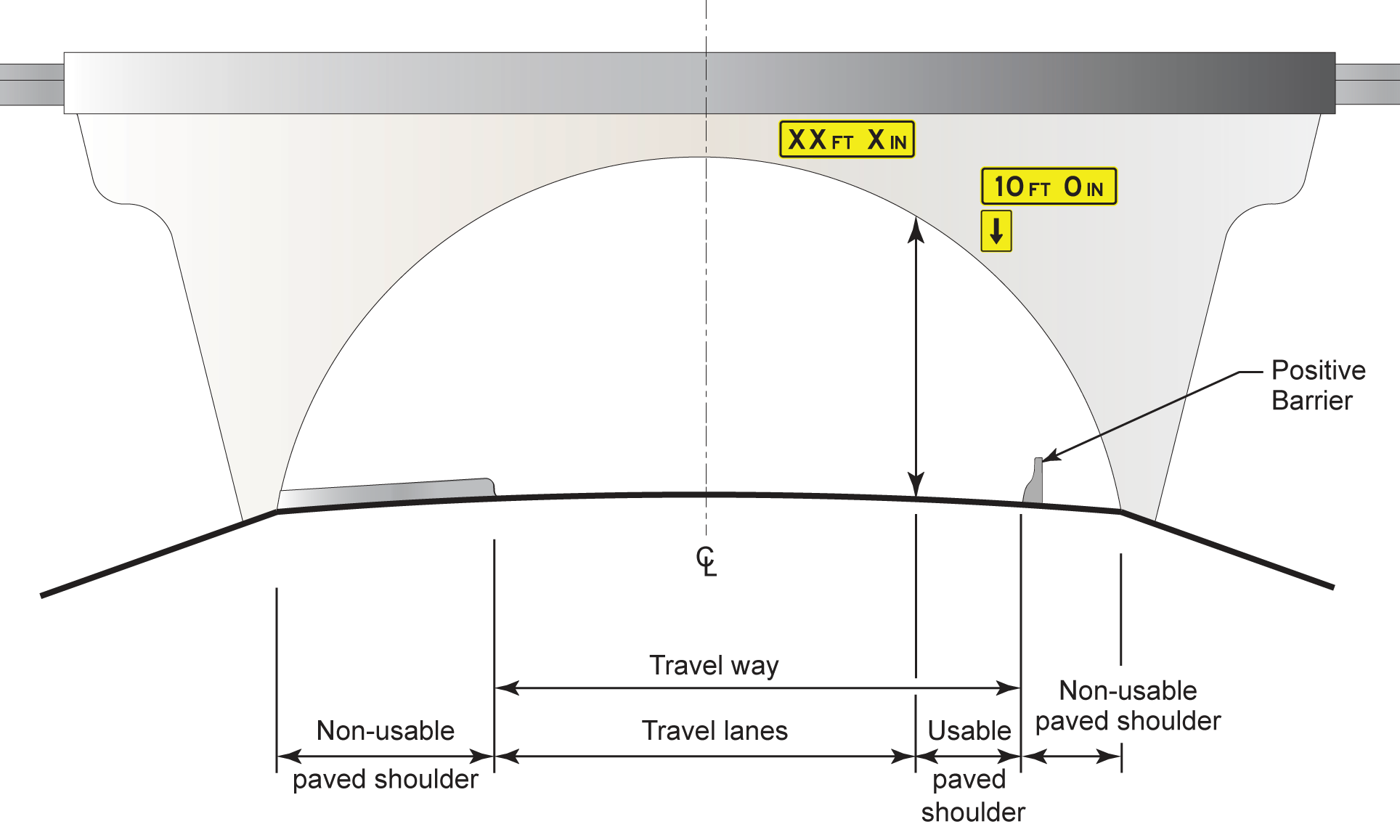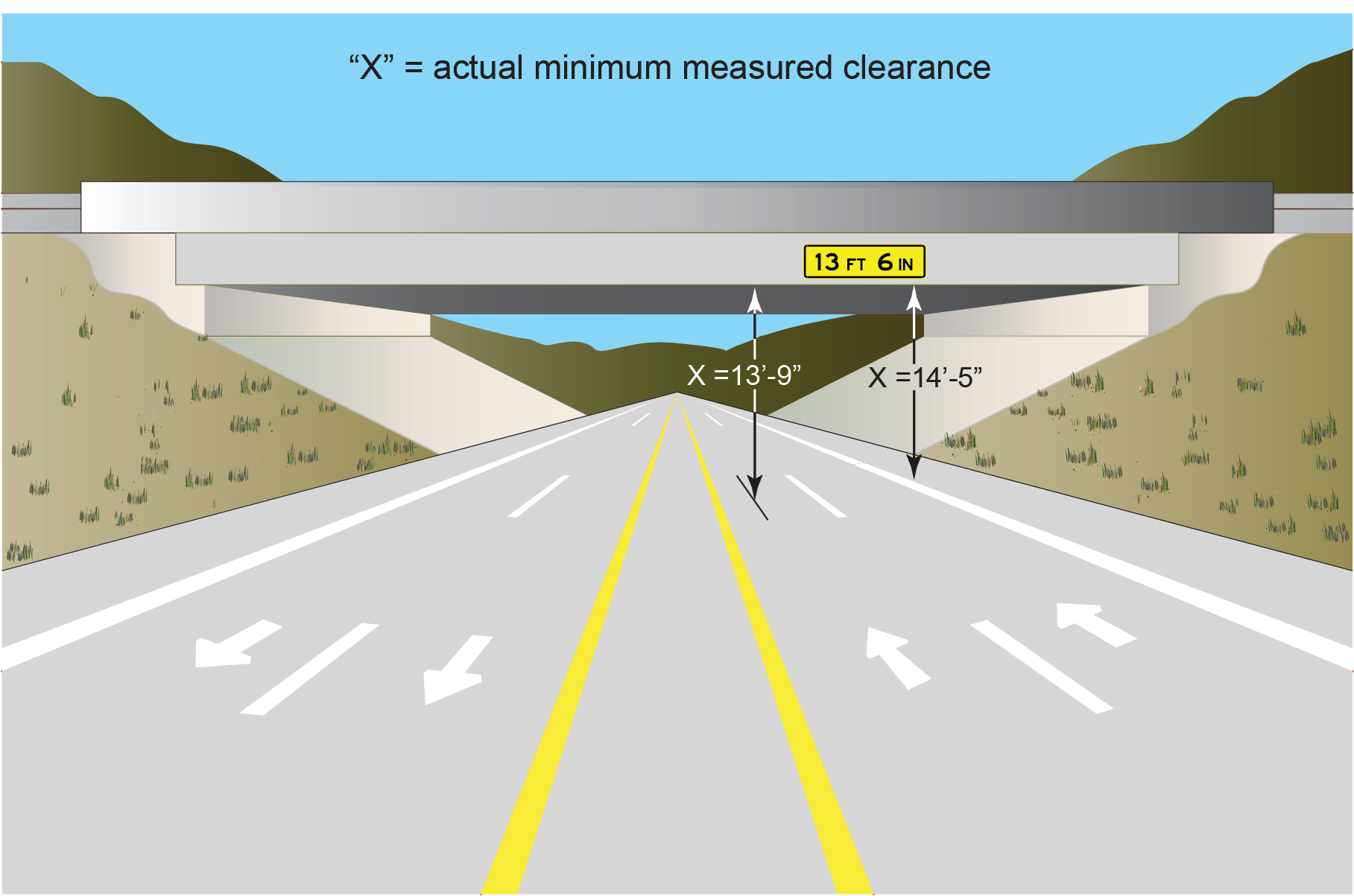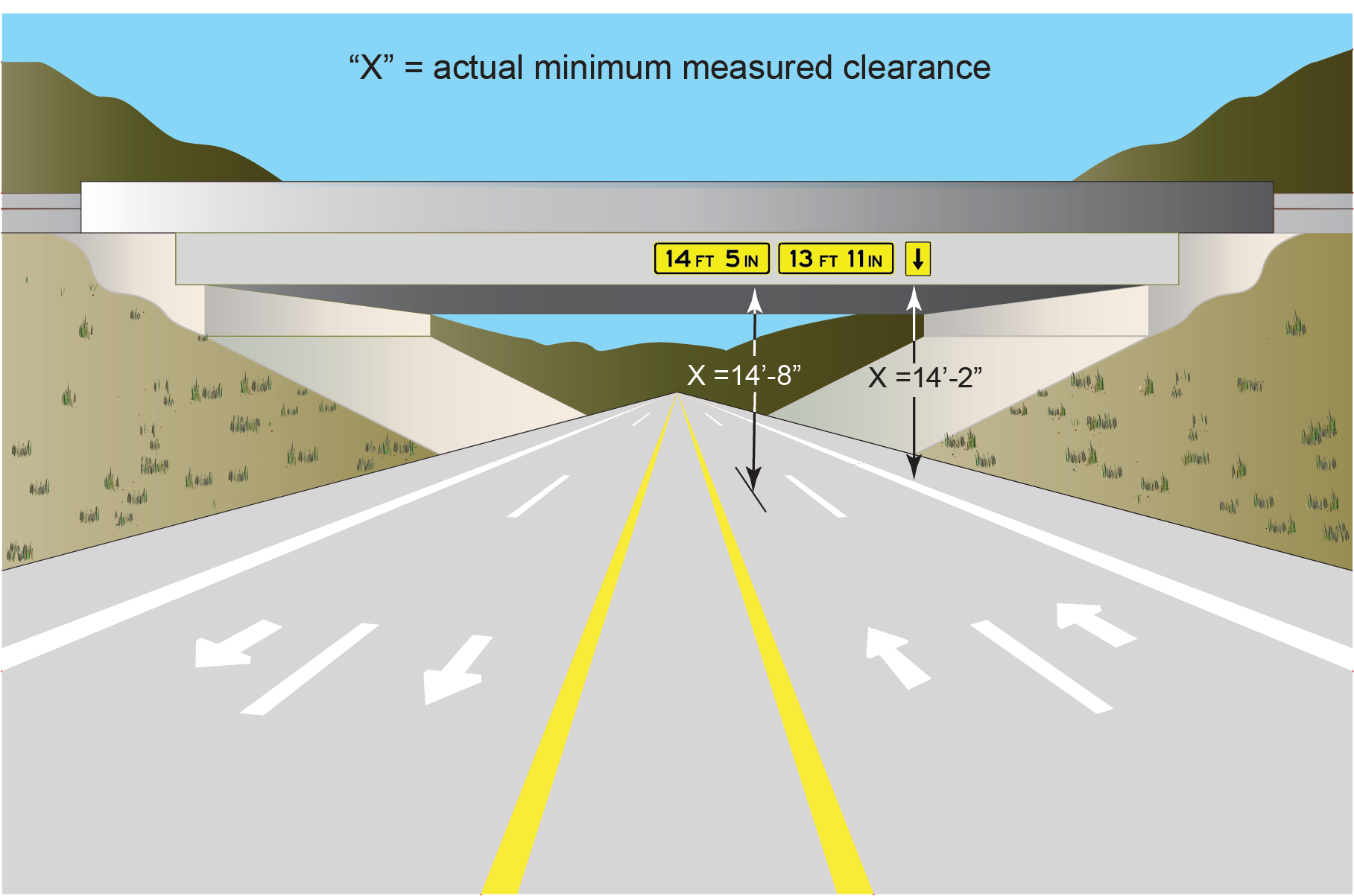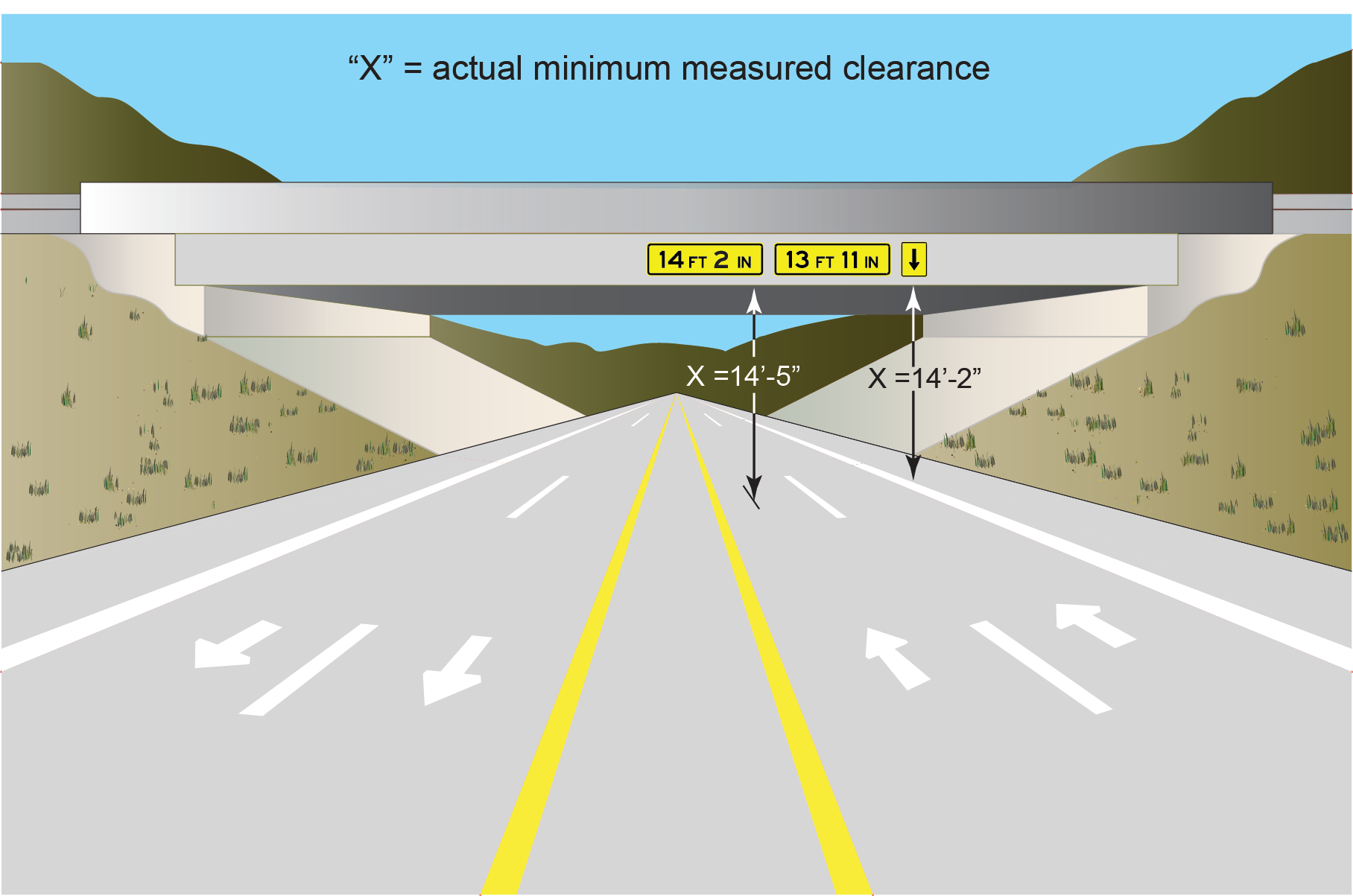Section 3: Vertical Clearance
Anchor: #i1000027Introduction
Sections 621.207 and 621.504 of Chapter 621 of the Texas Transportation Code restrict a vehicle and its load to a height of no more than 14 feet, unless an oversize/overweight permit is obtained from the Texas Department of Motor Vehicles (TxDMV). Furthermore, it is unlawful to operate a vehicle over or on any bridge or through any underpass or similar structure unless the height of the vehicle, including its load, is less than the vertical clearance of the structure as posted by the Texas Department of Transportation (TxDOT).
Anchor: #i1000087Signs
CLEARANCE signs (W12-2, W12-2a and W12-4T) need to reflect the vertical clearance between the roadway and the overhead obstruction.
This section provides guidelines intended to supplement the Texas Manual on Uniform Traffic Control Devices (TMUTCD). Consult the TMUTCD for more information on this topic and for specific information concerning sign placement criteria.
Anchor: #i1000122When to Measure
Vertical clearance may change with milling operations, overlays, and new construction. All construction or maintenance activities which may affect the vertical clearance of an overhead structure should be coordinated with the district oversize/overweight permit coordinator in advance to ensure that accurate and current records are maintained.
Any condition that could result in a change to the vertical clearance, such as an overlay or reconstruction of the roadway, requires new measurements.
Anchor: #i1000147How to Measure Minimum Vertical Clearance
Minimum vertical clearance measurements apply to the total travel way, which includes the travel lanes and any usable paved shoulder. A usable shoulder is defined as a paved surface adjacent to and flush with the travel lanes for which the minimum measured clearance is not less than 10 feet. Where a paved shoulder, or section of paved shoulder, passes beneath an overhead obstruction with a minimum vertical clearance less than 10 feet, the installation of a positive barrier should be considered as an additional roadside safety treatment (see Figure 6-2). An elevated paved shoulder at the edge of the travel lanes is not included in clearance measurements. Similarly, raised medians are not considered part of the travel way.
Figure 6-2. Measuring minimum vertical clearance
A sufficient number of measurements should be taken across the width and depth of the obstruction to ensure that the minimum clearance is determined. Measurements should be rounded down to the lowest whole inch.
Anchor: #i1004877Signing Minimum Vertical Clearance
The signed clearance (the clearance shown on the sign) should be three inches less than the actual measured clearance. This establishes a clearance buffer to allow for future surface overlays. The following signing requirements are summarized in Figure 6-3.
Structures Not Requiring Signing. Overhead obstructions with minimum clearances exceeding 20 feet do not require any clearance signs. The clearance signs should not be applied to overhead sign support structures.
Structures Requiring Signing. All overhead obstructions, except overhead sign structures, that have a minimum measured clearance of 20 feet or less require both advance CLEARANCE (W12-2) and structure mounted ( ) FT ( ) IN clearance (W12-2a) signs, unless the immediately preceding structure is lower and no access (entrance or exit ramps, driveways, or intersections) for traffic exists between the structures. When the advanced CLEARANCE sign legend is less than 14 feet, 6 inches, the LOW CLEARANCE plaque (W12-2TP) should be included on the advance sign assembly.
The W12-2 sign must not be located between a MERGE sign and the entrance ramp or between an EXIT DIRECTION sign and the exit ramp. See the TMUTCD for more sign placement information.
Figure 6-3. Initial determination of need for warning signs for overhead obstructions. (Signed clearance should be three inches less than the actual measured clearance.)
When the minimum measured clearance over the travelway is less than 14 feet, 9 inches, use the following CRITERIA to determine the necessary signing.
|
Criterion |
If... |
Then... |
|---|---|---|
|
1 |
the minimum measured clearance over the travelway is located within the travel lanes, |
only one clearance sign is required at the obstruction (see Figure 6-4 for example). |
|
2 |
the difference between the minimum measured clearance above the travel lanes and the minimum measured clearance above the usable shoulder is 6 inches or greater, |
the travel lane and shoulder clearances should be signed independently on the structure (see Figure 6-5 for example); otherwise, only one clearance sign is required. |
|
3 |
the minimum measured clearance over the travel lanes requires a signed clearance greater than or equal to 14 feet, and if the minimum measured clearance over the usable shoulders requires a signed clearance of less than 14 feet, |
the travel lane and shoulder clearances should be signed independently (see Figure 6-6 for example). |
Figure 6-4. Criterion 1. If the shoulder clearance is greater than that of the travel lane, then only one sign is required.
Figure 6-5. Criterion 2. If the difference between the minimum measured clearance above the travel lanes and the minimum measured clearance above the usable shoulder is six inches or greater, then the travel lane and shoulder clearances should be signed independently on the structure.
Figure 6-6. Criterion 3. If the minimum measured clearance over the travel lanes requires a signed clearance greater than or equal to 14 ft., and if the minimum measured clearance over the usable shoulders requires a signed clearance of less than 14 ft., then travel lane and shoulder clearances should be signed independently.
Shoulder Clearance Signing. When an additional clearance sign is installed over a shoulder, the advanced CLEARANCE signs (W12-2) should indicate the same clearance as shown on the sign mounted over the travel lanes. Additional CLEARANCE signing for the shoulder must include a downward arrow plaque (W12-3TP). The downward arrow plaque should be located adjacent to the shoulder CLEARANCE sign and centered over the point for which the signed clearance applies, typically the outside edge of the usable shoulder.
Anchor: #i1007412Reporting Measurements
Whenever vertical clearance measurements are taken, both the actual and the signed clearance should be reported to the district oversize/overweight permit coordinator and to the district bridge inspection personnel.
The Motor Carrier Division of the TxDMV bases the clearance shown on the district permit maps on correspondence from each district. The vertical clearances on the district permit maps should show clearances in one-half foot increments, but never greater than the signed clearance.
Anchor: #i1007497Updating Vertical Clearance Signing
Vertical clearances must be measured immediately after any construction or maintenance activity that could affect the minimum vertical clearance of a structure. If the minimum measured clearance is less than or equal to the existing signed clearance, then the clearance sign must be replaced or modified and the district oversize/overweight permit coordinator should be notified before traffic is allowed to pass under the obstruction. If the minimum measured clearance is greater than the existing signed clearance and the clearance buffer (described under "Signing Minimum Vertical Clearance") is less than two inches, then the clearance sign legend should be changed as soon as practicable. The following table summarizes these directions.
|
If the measured overhead clearance is... |
Then... |
|---|---|
|
less than or equal to the existing signed clearance, |
replace the signs and notify the district oversize/overweight permit coordinator prior to opening the roadway to traffic. |
|
greater than the existing signed clearance but not by at least two inches, |
replace the signs. |
|
greater than the existing signed clearance by at least two inches, |
existing signs are okay. |
|
NOTE: The actual measured clearance should be three inches greater than signed clearance. If the existing signed clearance is within an inch of the correct signed clearance (3 inches ±1 inch of the actual measurement), the warning signs do not require replacement. |
|




